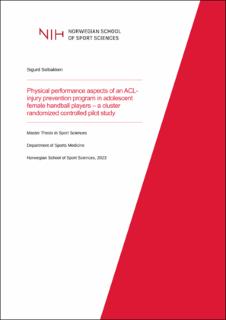| dc.description.abstract | Background: High knee abduction moments (KAM) are a significant risk factor for anterior cruciate ligament (ACL) injury in CoD and sidestep cutting. However, the influence of training interventions on KAM during these tasks remains unclear. To promote the implementation of injury prevention programs (IPP) in athletes, a secondary aim of improving physical performance (PP) should be incorporated.
Purpose: The purpose of this cluster-randomized controlled pilot study was to investigate the effect of an ACL- injury prevention intervention on isometric strength and CoD performance in adolescent female handball players. Furthermore, we wanted to investigate the association between IS and CoD performance.
Methods: Forty-nine adolescent female handball players (age 16.73 ± 0.9 years) from three Norwegian high schools participated in the eight-week intervention study. The schools were randomized to an intervention group (IG) (n=22) or control group (CG) (n=27). The intervention consisted of three segments; (i) handball sidestep cutting-technique training, (ii) manual eccentric resistance training, and (iii) CoD technique training. Relative isometric force output (IFO) was measured to assess isometric strength in hip abduction (ABD), external hip rotation (EXT), and plantar flexion (PFL) was measured to assess pre-post change and IS-COD association.
Results: IG increased IFO significantly compared to the CG in PFL (4.94%, p = 0.039), but not ABD (5.67%, p = 0.319) or EXT (3.78%, p = 0.448). However, compared to the baseline measures, IG increased IS in all outcomes. IG did not improve CoD Total time (-3.43%, p = 0.118), but Phase 1 time was significantly reduced (-3.47%, p= 0.015). Moderate correlations for CoD Total time and all IS outcomes were observed pre-and post-intervention. Changes in IFO were not associated with changes in CoD total time.
Conclusion: Overall, the ACL- injury prevention intervention was unsuccessful in improving physical performance. IS was significantly associated with CoD performance at both time points. However, changes in IS were not associated with changes in CoD performance. | en_US |
